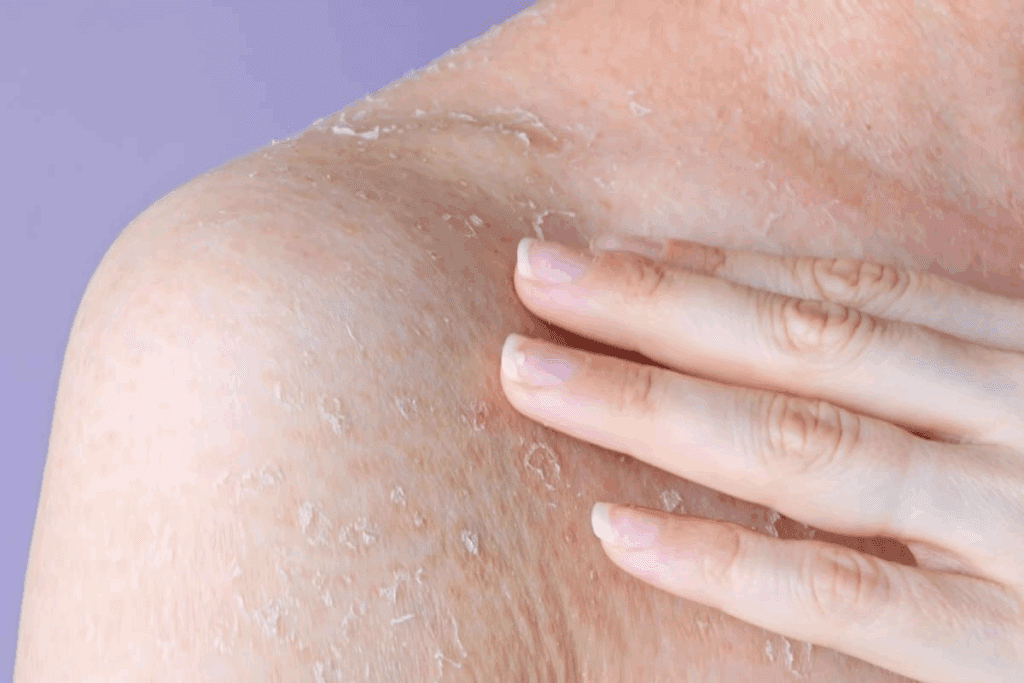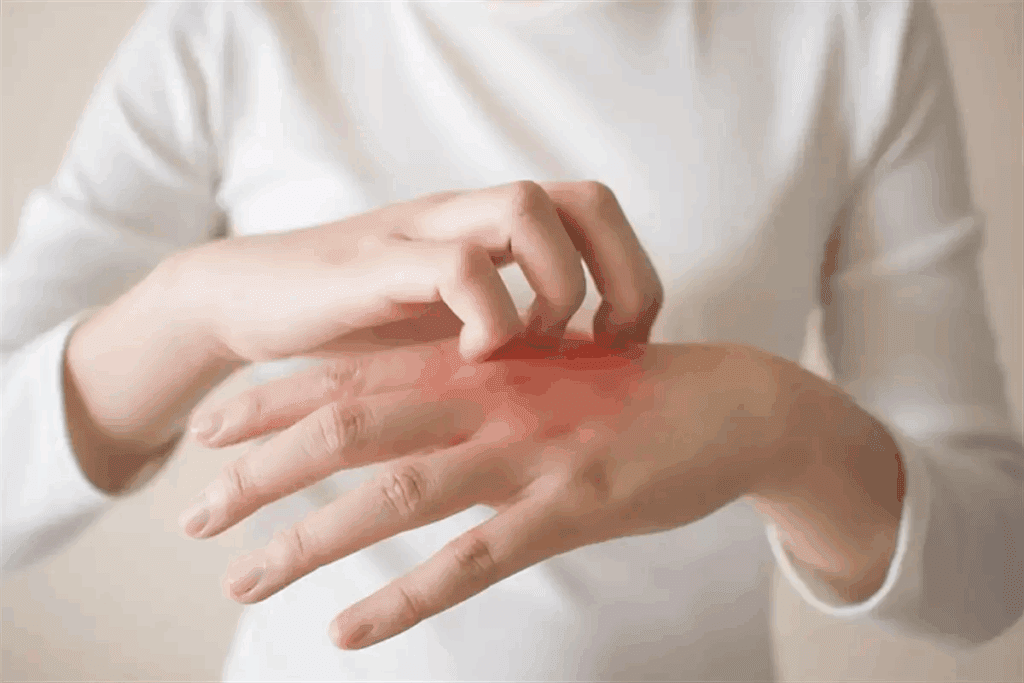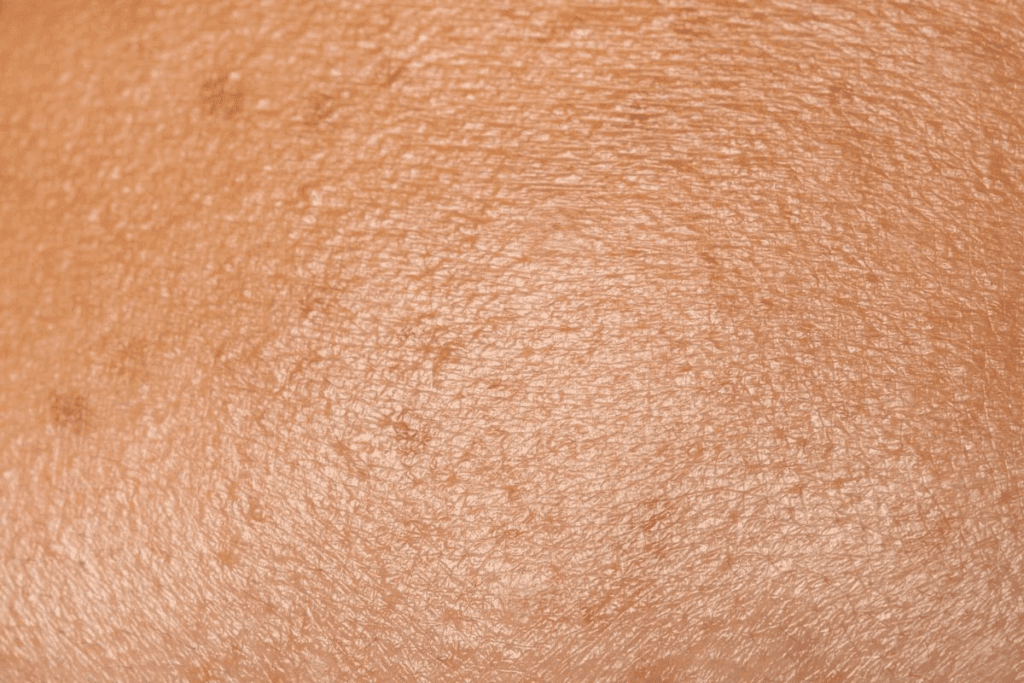Last Updated on November 20, 2025 by Ugurkan Demir

When unexplained pinpoint spots and itch show up on the skin, people want answers. At Liv Hospital, we focus on you to figure out the link between itching, petechial rashes, blanching, and fever.Discover can itching cause petechiae, petechial rashes, blanching, and fever for better awareness.
Petechiae are small, red spots on the skin from blood leaking from tiny blood vessels. Itching can sometimes cause minor skin damage, leading to these spots.
It’s important to understand how itching and petechiae are connected. Also, knowing about non-blanching petechiae and fever helps us decide the best treatment.

Petechiae are small spots on the skin that show up when tiny blood vessels break. They are usually red, purple, or brown and are less than 2 mm in size.
Petechiae are small and have a distinct color. They are less than 2 mm in diameter. This size is key in diagnosing them.
Petechiae can show up anywhere on the body. They often appear on the arms, legs, and trunk. They can also be found in the mouth and eyes.
Petechiae don’t change color when pressed, making them non-blanching. This is different from other rashes that do change color. Knowing this helps doctors diagnose petechiae correctly.
In short, petechiae are small, non-blanching spots on the skin and mucous membranes. Their size and color are important for doctors to diagnose them.

Itching and scratching can lead to petechiae, small spots on the skin. These spots are caused by minor skin trauma. Many skin conditions make itching a common symptom.
Scratching puts pressure on the skin, which can break small blood vessels. This can cause petechiae, mainly in fragile skin or where blood vessels are affected.
Scratching can cause petechiae by applying pressure to the skin. This pressure can break capillaries, leading to small hemorrhages. The risk of getting petechiae depends on how hard you scratch, the skin’s fragility, and any blood vessel issues.
Scratching can lead to petechiae, but it’s important to tell them apart. Pathological petechiae are linked to diseases like infections or blood disorders. They can appear anywhere, not just where you scratched.
| Characteristics | Trauma-Induced Petechiae | Pathological Petechiae |
| Location | Localized to scratched areas | May be widespread or in specific patterns |
| Cause | Direct result of mechanical trauma from scratching | Associated with underlying medical conditions |
| Distribution | Typically limited to areas subjected to scratching | Can be widespread or follow specific patterns related to the underlying condition |
Petechiae from scratching need careful attention. If they spread beyond scratched areas or come with fever, see a doctor. They might signal a serious issue that needs quick treatment.
In summary, itching and scratching can cause petechiae. But, it’s key to know the difference between trauma-induced and pathological petechiae. This helps manage them properly and address any underlying health issues.
Petechiae are known for not changing color when pressed, a key sign for doctors to spot them. This trait sets petechiae apart from other rashes and skin spots. Knowing what “non-blanching” means and how to spot it is important for both doctors and patients.
“Non-blanching” means petechiae don’t change color or fade when pressed. Unlike other skin spots, petechiae stay the same. This is because they are filled with blood that doesn’t move when pressed.
To understand this better, let’s consider the underlying mechanism. Petechiae happen when small blood vessels burst, spilling blood into the skin. When you press on them, the blood stays put, so the spot doesn’t change color.
The blanching test is a simple way to tell if a spot is petechiae. To do it, press a glass slide or clear plastic gently on the spot. If it’s petechiae, it won’t change color. You can do this test in a doctor’s office or at home with some guidance.
The blanching test is easy to do and very helpful for first checks. But, it’s important to look at all the signs and symptoms together.
| Lesion Type | Blanching Response | Typical Cause |
| Petechiae | Non-blanching | Bleeding into skin |
| Erythematous rash | Blanching | Inflammation or infection |
Petechiae don’t blanch because of how they form. When small blood vessels burst, blood spills into the skin, making spots. Because this blood is outside the vessels, pressing on it doesn’t move it, so the spots stay visible.
“The non-blanching characteristic of petechiae is a key diagnostic feature that distinguishes them from other rashes.”
Medical Literature
Knowing about petechiae’s non-blanching trait is key for correct diagnosis and treatment. By recognizing this and doing the blanching test, doctors can tell petechiae apart from other skin spots. This helps guide further tests and treatment.
Many people think petechiae can be blanchable. But, true petechiae don’t blanch. Knowing this is key for correct diagnosis.
Petechiae are often mixed up with other skin spots that can blanch. But, real petechiae don’t change color because they’re caused by bleeding into the skin.
Key characteristics of non-blanching petechiae include:
Some conditions look like petechiae but can change color. For example:
It’s important to tell these apart from real petechiae for the right diagnosis.
Getting skin lesions right is key. Doctors use the blanching test to tell different skin spots apart.
“The blanching test is a simple yet effective tool in diagnosing skin lesions. By applying pressure and observing the color change, healthcare providers can gain valuable insights into the nature of the lesion.”
Using the right tests, like the blanching test, is essential for correct diagnosis and care.
A petechial rash with fever is a serious warning sign. It could mean a severe infection, like meningococcemia. This is a medical emergency that needs quick action.
Fever and petechial rash together are very concerning. They often point to serious health issues. Meningococcal infection is one such condition that needs immediate care. We will look into what this means and what steps to take.
Fever shows the body is fighting an infection. A petechial rash suggests the infection might be affecting blood vessels or blood itself.
Meningococcal infection, caused by Neisseria meningitidis, is very dangerous. It can cause fever and petechial rash. Quick treatment is key to avoid serious problems or death.
| Symptom | Description |
| Fever | High body temperature, often above 38°C (100.4°F) |
| Petechial Rash | Small, non-blanching spots on the skin, often appearing as red or purple dots |
| Meningitis Symptoms | Headache, stiff neck, confusion, and sensitivity to light |
If you have a petechial rash with fever, get medical help right away. Quick action can greatly improve treatment outcomes for serious infections.
In emergency settings, doctors will first ask about your medical history and do a physical exam. They will also run tests to find out why you have fever and rash.
It’s vital to get a quick evaluation and proper treatment for serious conditions.
Petechiae can be caused by many things, like infections, blood disorders, and side effects from medicines. It’s important to look at all these possible causes. This helps doctors figure out what’s wrong and how to treat it.
Infections are a big reason for petechiae. Meningitis is very serious and can cause petechiae or purpura. It’s important to catch this early to help the patient.
Some viruses can also cause petechiae. These include:
Blood disorders can also cause petechiae. This is often because of low platelets or platelet problems. Some conditions to think about are:
Some medicines can also cause petechiae. This can happen because of how the medicine affects the bone marrow or the immune system. Some common medicines that might cause this include:
Knowing what can cause petechiae is very important for doctors. It helps them make the right diagnosis and start the right treatment. Looking at all possible causes is key to helping patients with petechiae.
The size of petechiae is very important in medical diagnosis. Knowing the size of these spots helps doctors tell them apart from other bleeding issues.
True petechiae are small, usually under 2 mm. This size helps doctors tell them apart from bigger bleeding spots. It’s key for diagnosing and treating patients with these rashes.
“Petechiae are small, pinpoint spots that occur due to bleeding from small capillaries,” as noted in medical literature. Their small size is a hallmark characteristic that aids in their identification.
Petechiae are often mixed up with purpura and ecchymoses. But they are different in size and what they mean for health. Purpura are bigger, between 2 mm and 1 cm, and ecchymoses are even bigger, over 1 cm.
Knowing these differences is key for correct diagnosis and treatment.
It’s important to document petechial lesions accurately. We suggest noting their size, number, and where they are on the body at each visit. This helps see if treatment is working and if changes are needed.
By watching petechial lesions closely, doctors can catch problems early. This helps in managing patients with these rashes well.
Knowing the difference between trauma and pathological petechiae is key for better patient care. Trauma petechiae come from physical injury. Pathological petechiae are linked to health issues. It’s important to know the difference for the right treatment.
Trauma petechiae show up where there’s been scratching or pressure. They often form in lines or groups, matching the injury site. Pathological petechiae, though, spread out more and don’t always follow injury patterns.
The look of petechiae can also tell us something. Trauma petechiae usually have other signs of skin injury. Pathological petechiae might come with fever or fatigue, showing there’s an illness.
It’s important to look at the whole picture to tell trauma from pathological petechiae. For example, fever might mean an infection like meningococcal infection. On the other hand, petechiae from scratching usually stay in one spot.
The way petechiae appear, change, and heal can also tell us what they are. Trauma petechiae usually go away once the cause is fixed. But pathological petechiae might stay or change based on the illness.
Even though most trauma petechiae are okay, sometimes we need to look closer. If the petechiae seem too big for the injury, or if there are other symptoms, we should check for bleeding disorders or other issues.
In summary, telling trauma from pathological petechiae needs us to look at where they are, what symptoms they come with, and the bigger picture. By understanding these differences, doctors can make better diagnoses and treatments.
When we see non-blanching petechial rashes, we need a detailed plan to figure out what’s causing them. This plan includes checking the patient physically, doing lab tests, and sometimes special tests. It’s important to carefully look at the patient to find the root cause.
The first step is a detailed physical check-up. We look at the rash’s size, shape, and where it is. We also check for fever, swollen lymph nodes, or big liver and spleen. These signs can help us guess what might be wrong.
Lab tests are key in figuring out what’s going on. We start with a blood test to check platelets, white blood cells, and hemoglobin. We might also do blood cultures, coagulation tests, and liver function tests. Sometimes, we need X-rays or CT scans to look for hidden problems.
In some cases, we need special tests to make a clear diagnosis. This might include bone marrow biopsies for blood disorders or lumbar punctures for meningitis. We decide on these tests based on the patient’s symptoms and lab results.
It’s very important to check for serious and dangerous conditions. We watch for signs of meningococcal infection, leukemia, or other severe diseases. By using a combination of physical checks, lab tests, and imaging, we can find the cause of the rash and start treatment right away.
The treatment of petechiae depends on finding and treating the root cause. A good plan considers the patient’s health, how serious the condition is, and any other symptoms. This approach helps manage the situation effectively.
For infections like meningitis, antibiotic therapy is key. Viral infections might need antiviral medications. If petechiae come from blood disorders, treatments focus on managing blood counts.
Medication side effects can also cause petechiae. Changing or stopping the drug under doctor’s watch can help.
While treating the cause is important, symptomatic management is also vital. It helps reduce discomfort, prevents skin damage, and manages symptoms like fever or pain.
In severe cases, like with fever or alarming symptoms, hospitalization may be necessary. This is true for serious infections like meningococcal infection.
Hospital care allows for close monitoring and treatments like antibiotics or fluids. These are critical for severe infections.
After treatment, follow-up care is key to track petechiae resolution and watch for complications. Regular check-ups and sometimes more tests are needed to ensure the cause is managed well.
Understanding the value of follow-up care helps patients manage their condition better. It also lowers the chance of future problems.
Understanding petechiae is key for doctors and patients. These small spots on the skin can show many health issues, some serious. We’ve seen how scratching can lead to petechiae, showing the link between skin damage and these spots.
Petechiae are important because they can point to serious health problems, like fever. It’s important to know the difference between petechiae that fade when pressed and those that don’t. The latter can signal life-threatening conditions, like meningococcal infection.
Getting a quick diagnosis and right treatment for petechiae is vital. This helps tackle the root cause and avoid worse problems. Doctors can give better care by knowing what causes petechiae and how to spot them.
In short, petechiae need careful checking. Their importance should not be ignored. Knowing about petechiae and fever, and how itching can cause them, is key. This ensures quick medical help when it’s needed.
Petechiae are small spots on the skin or mucous membranes. They happen when there’s a minor bleed. These spots are usually under 2mm and don’t disappear when pressed.
Yes, itching and scratching can lead to petechiae. But, it’s important to tell them apart from those caused by health issues.
A petechial rash with fever is a serious sign. It means you need to see a doctor right away. It could be a sign of a serious illness like meningococcal infection.
Petechiae are small, don’t fade when pressed, and are found in certain places. They’re different from purpura and ecchymoses because of their size and where they appear.
Non-blanching means petechiae don’t change color when pressed. This is how you can tell them apart from other rashes.
To do the blanching test, press a glass slide or finger on the rash. If it doesn’t fade, it’s a sign of petechiae.
Yes, petechiae are always non-blanching. But, other conditions might look similar and need different treatment.
Petechiae can come from infections, blood disorders, or some medicines. Finding the cause is key to treating them.
Treating petechiae means fixing the cause. This might mean treating an infection, managing blood issues, or stopping certain medicines. Sometimes, you need to go to the hospital.
Knowing the size of petechiae helps tell them apart from other bleeding spots. True petechiae are usually under 2mm.
If trauma-related petechiae spread, come with fever, or seem like something more serious, you should check further.
Subscribe to our e-newsletter to stay informed about the latest innovations in the world of health and exclusive offers!